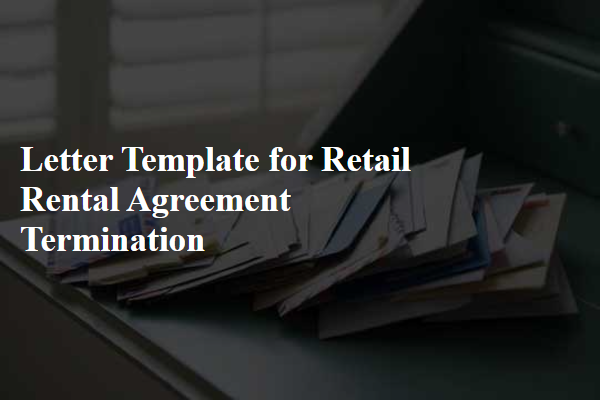Are you considering terminating your retail rental agreement? Navigating the ins and outs of lease termination can be overwhelming, but it doesn't have to be. In this article, we'll guide you through the essential steps, from understanding your lease terms to drafting a formal termination letter. So, grab a cup of coffee and let's delve into the detailsâyour journey to a smooth transition starts here!

Clear statement of termination
The termination of a retail rental agreement constitutes a formal communication indicating the end of the leasing relationship between a landlord and tenant. This process requires a written notice typically delivered 30 to 90 days prior to the intended termination date, depending on lease terms. Key elements within the termination notice include the full names of both parties, the retail property address (such as 123 Market Street, Anytown, USA), the effective termination date, and any necessary confirmation of outstanding obligations, such as security deposit returns. To ensure clarity, the notice should specify reasons for termination if applicable (e.g., breach of contract, business closure), while also adhering to any state-specific regulations regarding rental agreements. Proper delivery of this document, whether via certified mail or personal handover, ensures legal validation of the termination process.
Effective termination date
Retail rental agreements often include specific provisions for termination. The effective termination date is critical in ensuring both parties understand when the lease will officially end. Landlords and tenants may specify this date in advance, for instance, notifying each other at least 30 days before the intended termination. Additionally, local regulations may dictate minimum notice periods, which can vary significantly between different jurisdictions. Clear communication regarding the effective termination date helps avoid misunderstandings and potential disputes. Tenants should also ensure that they settle any outstanding payments or obligations related to the lease prior to the effective termination.
Reason for termination
Retail rental agreement termination can occur for various reasons, such as business closure, lease non-renewal, or breach of contract. A common reason involves financial difficulties faced by the tenant, leading to an inability to meet rental payments. Additionally, a tenant may terminate due to unsatisfactory property conditions, such as lack of maintenance in shopping centers or adverse impacts from neighboring businesses. Another reason could be changes in local market dynamics, prompting the tenant to seek better locations or different lease terms. Urban areas like Manhattan or Los Angeles might exemplify places where high competition and fluctuating rent prices influence termination decisions. In some cases, landlords may terminate due to the tenant's failure to adhere to lease agreements, including excessive alterations to the retail space or illegal activities on the premises.
Return of property condition
Upon termination of the retail rental agreement, the return of the property must meet specific condition standards. The commercial space, located at 123 Main Street in Downtown, should be cleaned thoroughly, including removal of all personal items and inventory. Walls should be free from any damage such as holes or peeling paint, and floors should be polished to remove any scuff marks or stains. Additionally, all fixtures, including lighting and shelving units, must be returned in their original functioning state. Any alterations made during the tenancy that are not authorized should be rectified, and keys must be returned to the landlord within 14 days following the termination date detailed in the agreement. Failure to comply with these conditions may result in deductions from the security deposit to cover necessary repairs and cleaning costs.
Contact information for further communication
When a retail rental agreement reaches its termination, it is essential to include clear contact information for any further communication regarding the process. A tenant or landlord should provide the following details: full name, current mailing address (including city, state, and ZIP code), email address for quick digital correspondence, and a phone number available during business hours for urgent inquiries or clarifications. Including details about a specific contact person, if applicable, can enhance communication efficiency. Furthermore, it may be beneficial to mention any specific deadlines for returning security deposits or completing property inspections to ensure a smooth transition upon the agreement's conclusion.
Letter Template For Retail Rental Agreement Termination Samples
Letter template of retail rental agreement termination due to lease expiration.

Letter template of retail rental agreement termination for non-payment of rent.

Letter template of retail rental agreement termination for breach of contract.

Letter template of retail rental agreement termination by mutual consent.

Letter template of retail rental agreement termination for property damage.

Letter template of retail rental agreement termination for unauthorized alterations.

Letter template of retail rental agreement termination due to business closure.

Letter template of retail rental agreement termination for landlord's redevelopment.

Letter template of retail rental agreement termination due to health and safety violations.





Comments